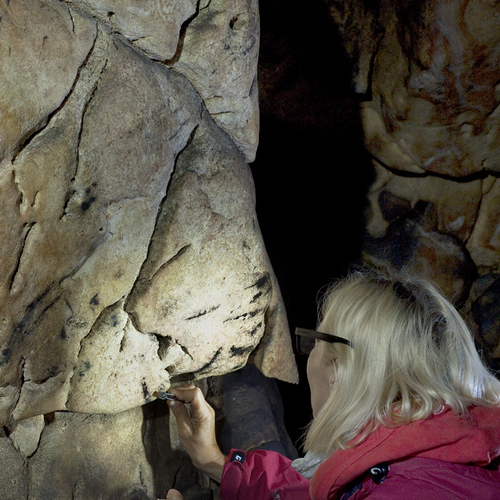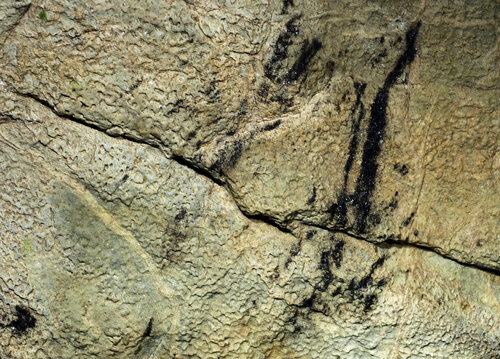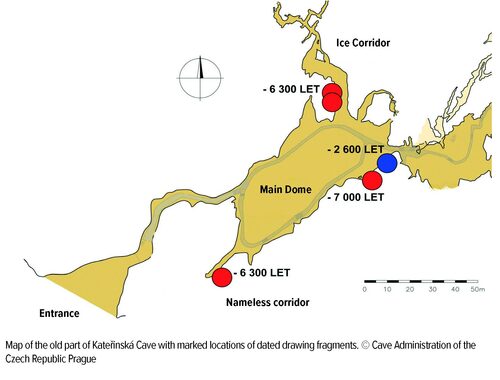Nature Conservation 2021 — 10. 6. 2021 — Research, Surveys and Data Management
The Latest Epigraphic Research Has Shifted back the Age of the Oldest Cave Drawing Traces in the Cze
Since 2016, epigraphic research has been carried out in the caves of the Moravský kras/Moravian Karst (South Moravia), with the participation of the Cave Administration of the Czech Republic (CACR), Palacký University Olomouc (PU), and the Nuclear Physics Institute of the Czech Academy of Science Prague (NPI CAS). In 2019, the surprising results of radiocarbon dating of some black charcoal drawing traces in the Kateřina Cave had revealed them to be of prehistoric age (approx. 6,300 years). For more details, see Ochrana přírody/Nature Conservation Journal, 74, 5, 39-41, 2019. During detailed documentation of these objects, some other interesting clusters of lines and shapes were discovered there. Analysis of one of them revealed that they are even older, namely more than 7,000 years.
The old part of the Kateřina Cave has been known since time immemorial and its massive portal served prehistoric people in the late Neolithic as a settlement. Earlier archaeological findings and remains of fireplaces testify to this. There was speculation as to whether people were already visiting a huge area during this period – namely the Main Dome, which is located behind a 60-metre-long low corridor. The fact that there have been frequent visits in the past centuries is obvious, as evidenced by the signatures and inscriptions on the walls in various parts of the Main Dome and in its branches. Fragments and traces of black charcoal drawings dated in 2019 using radiocarbon analysis showed that the spaces were visited by humans even in prehistory.

Sampling of charcoal from drawing fragments taken for analysis. © Petr Zajíček
After finding other interesting objects, clusters of lines and abstract shapes, some of them were selected for further study and black charcoal sampling for dating. Once again, a team of experts from the CACR, PU, and NPI CAS took part in this stage of research. However, the sampling was carried out with the participation of other experts – Czech and Slovak archaeologists on August 29, 2019. A total of six samples were taken using a proven sensitive methodology: three in the Ice Corridor (located near prehistoric objects dated from the previous series of samples); two from the Main Dome walls; and one in the nameless corridor (also near the previously dated prehistoric drawing traces). The processing of the collected material was again performed by the NPI CAS. The analyses themselves were performed in laboratories in Debrecen, Hungary.

Drawing fragments in the Main Dome, approx. 2,600 years old. © Petr Zajíček
7,000 year age limit has been passed
Relevant results of the analyses were available only in March 2020. Samples from four collected objects did not have enough black charcoal for exact analysis. Only two samples were dated, both taken from drawing fragments in the north-east part of the Main Dome. The first of them, with an age of approx. 2,500-2,800 years, fits into the Hallstatt period. The fact is also surprising, because a drawing or a fragment/trace from this period has not previously been found in the Moravský kras/Moravian Karst. The second sample was dated to a period approx. 7,000–7,200 years ago. Coincidentally, these are irregular clusters of black charcoal lines on a prominent rock protrusion, from which black charcoal samples had already been taken twice for analysis, but the amount was not sufficient. The surprising result was supported by the fact that humans in the late Neolithic repeatedly visited various places in the Kateřina Cave´s old part and left evidence on it there. Thus, the last dated drawing fragment is thus the oldest document of such type in the caves in the Czech Republic.
Interesting drawing traces that could not be dated
It was not possible to exactly analyse the black charcoal drawing fragments from which black charcoal samples were taken due to the small amount of extracted black charcoal. This is a clusters of lines in the Ice Corridor, reminiscent of primitive drawings of human figures. Similar drawings were found in the Bestažovca Cave in Slovenia and dated to an age of approx. 6,700 years ago. The similarity of the drawings in the Slovenian cave and those from the Kateřinská Cave is striking. It is a great pity that it was not possible to date the objects from the Kateřinská Cave. The only fact that can be stated is that they are located near two prehistoric, previously dated drawing traces in the Ice Corridor (approx. 6,300 years old). Thus, there is a high probability that the drawing fragments resembling figures could also come from the late Neolithic period.
The purpose of prehistoric drawing fragments
The question is whether these are random abrasion marks from torches or whether the line or primitive drawings were created by prehistoric humans intentionally.
The character of some of these objects does not indicate that it is a mere abrasion. Interestingly, in the nearby Koňská jáma/Horse Hole Cave, where archaeological findings from the same period have been made, there are no similar black charcoal fragments. Therefore, archaeologists thus assume that in the Kateřinská Cave it was probably an intentional activity. In certain parts of the cave, humans could thus mark places that served them, e.g. for underground ritual ceremonies. However, in the Main Dome of the old Kateřinská Cave and in the adjacent corridors, no detailed archaeological research has yet been carried out to confirm the assumption. Prehistoric drawing traces found in the Kateřinská Cave shall be further studied and documented in detail. The aim of the ongoing research is to find out other connections with earlier archaeological findings in the Kateřinská Cave portal and in surrounding caves.


